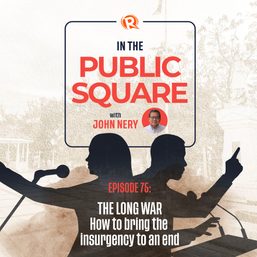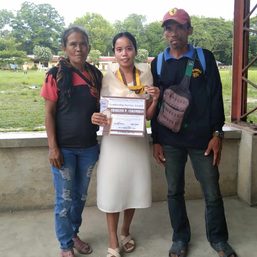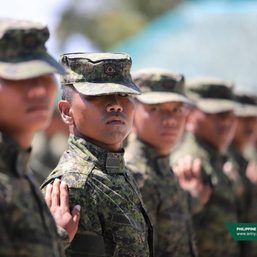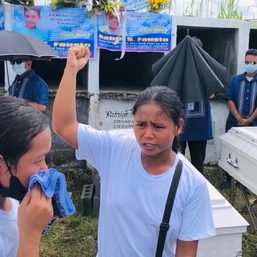SUMMARY
This is AI generated summarization, which may have errors. For context, always refer to the full article.
![[OPINION] Whatever happened to NPA’s vow to probe Masbate killings?](https://www.rappler.com/tachyon/2021/12/Masbate-NPA-TL.jpg)
It has been 6 months since the Masbate incident of June 6, June 2021, that saw the tragic killing of 21-year old scholar-athlete Kieth (not Keith) Absalon and his 40-year-old cousin, union leader Nolven Absalon. They were riding on bicycles when hit by a landmine or improvised explosive device (IED) blast caused by a New People’s Army (NPA) unit in the Masbate City coastal outskirts.
On its second-month anniversary last August 6, we asked where the calls for justice, especially by the aggrieved Absalon family, were going. I wrote about two ongoing investigations at the time, that of the government through the Masbate City Prosecution Office (CPO) and that of the NPA. I also advocated for independent investigators and observers, citing particularly the Philippine Commission on Human Rights (CHR) that has proven its independence in investigating human rights and international human rights law (IHL) violations by both sides.
As it turns out, it has been the CHR through its Region 5 (Bicol) office in the form of 3 separate resolutions dated July 7, 2021 and the Masbate CPO in the form of a joint resolution dated July 30, 2021, which have already issued their investigation or preliminary investigation reports, while none has been forthcoming from the NPA, whether from its operational commands for Bicol (Romulo Jallores Command) or for Masbate (Jose Rapsing Command).
The CHR Region 5 resolutions and the Masbate CPO Joint Resolution can be instructive in the search for justice for the Absalon family and the NPA perpetrators. Allow us to report on and proffer a few comments on these resolutions, especially from the prism of human rights and IHL, in the spirit of continuing legal education and learning. As such, this partakes of an academic discussion, with some attention to the landmine use issue, that is no way meant to influence the already ongoing court cases proceedings before the Regional Trial Court of Masbate City.
The court proceedings are however limited so far to only 3 accused, who are lady public elementary school teachers and sisters Suslon, whose father is a wanted NPA element but is not among the 24 named accused, 21 of whom are still at large, as far as I know as of this writing. These 24 accused appear to be the same respondents in the CHR Masbate CPO investigations where the complaints were filed by Absalon next of kin and the Masbate City Central Police Station which prepared, gathered, and submitted the supporting sworn statements, including crucially that of surviving victim Chrysvine, and forensic evidence, both on the explosion remnants and on the medico-legal examination on the bodies of the victims.
Human rights instruments
These 3 resolutions in CHR-V-2021-0268 to 0280 correspond to the 3 victims of the Masbate incident: the 2 fatalities Kieth and Nolven, and the one injured survivor, 16-year old Chrysvine Daniel. The contents of the 3 resolutions are basically the same, but with added legal and human rights aspects for the minority or child status of Chrysvine. The issue for the CHR in all 3 cases was whether the 24 respondents and alleged NPA members led by Eddie “Ka Star” Rosero committed human rights violations against the 3 victims.
For the CHR, the applicable human rights (HR) instruments consisted of both international and domestic instruments. For the international instruments, the CHR cited 4 of these:
- Universal Declaration of Human Rights, Article 3 on the right to life and security of person
- International Covenant on Civil and Political Rights, Article 6(1) on the inherent right to life.
- Geneva Conventions of 1949, Common Article 3(1)(a) prohibition on violence to life and person, in particular murder of all kinds
- Additional Protocol II of the Geneva Conventions, Article13 on protection of the civilian population, particularly par. (2) that civilians shall not be the object of attack
For the domestic instruments, the CHR cited 3 of these:
- 1987 Philippine Constitution, Article III, Section 1 on non-deprivation of life without due process
- Philippine Act on Crimes Against International Humanitarian Law, Genocide and Other Crimes Against Humanity (Republic Act No. 9851), several provisions including on the war crime of directing attacks against civilians not taking direct part in hostilities [this is Section 4(c)(1)]
- Revised Penal Code, Article 248 on Murder
In the case of the surviving injured minor victim Chrysvine whose finger was amputated, the CHR added as a domestic instrument of reference the Special Protection on Children in Situations of Armed Conflict Act (R.A. No. 11188), Section 9(a) prohibiting grave child rights violations, including (3) intentional maiming of children, as well as the Section 7(f) right to be protected from maiming.
Another domestic instrument cited by the CHR was the GRP-NDFP Comprehensive Agreement on Respect for Human Rights and International Humanitarian Law (CARHRIHL), several provisions including Part III, Article 2(3) on the right of the victims and their families to seek justice for violations of human rights, including adequate compensation or indemnification, restitution and rehabilitation, and effective sanctions and guarantees against repetition and impunity. The CHR most significantly posits that “The CARHRIHL is not only an agreement between the Government of the [Republic of the] Philippines and the CPP/NPA/NDF [Not just the NPA but also the Communist Party of the Philippines and the National Democratic Front] but it is also recognized as a human rights instrument.” (Emphasis mine.)
For this, the CHR cites the concurring opinion of Supreme Court Associate Justice Marvic Leonen in the 2014 decision of the Court in the case of Ocampo vs. Abando: “This agreement establishes the recognition of the existence, protection, and application of human rights and principles of international humanitarian law as well as provides the following rights and protections to individuals by the CPP/NPA/NDF.” Stated otherwise, this non-state armed group is recognized as also a duty-bearer for human rights (not just IHL), and consequently can be held accountable for human rights violations (not just IHL violations) just like states or governments and the security forces.
Debunking NPA’s claim
On this basis, the CHR “measures the CPP-NPA’s undertaking, based on the provisions contained in the CARHRIHL. Thus, the undersigned [CHR Region 5 Attorney IV Atty. Xaviera Marie V. Revereza, approved by Regional Human Rights Director Atty. Arlene Q. Alangco] rules that the NPA committed not just a plain human rights violation but a grave one.” Earlier, the CHR had noted the separate CPP-NPA statements of NPA Bicol Regional Operational (Romulo Jallores) Command spokesperson Raymundo Buenferza and of CPP Chief Information Officer Marco Valbuena, both on 8 June 2021, taking full responsibility for the “June 6 Masbate tragedy.”
The CHR ruling elaborates: “The claim of the CPP-NPA that the killing of KIETH (and NOLVEN) was done unintentionally appeared to be misled. As positively witnessed by CHRYSVINE, KIETH (and NOLVEN) was still alive after the blast. Had it not [been] for the series of gunshots fired by the respondents, he could have been rescued and given timely medical attention that could have saved his [life]. The respondents targeted the victim and fired gunshots deliberately inflicting severe damage and impunity.The two (2) IED blasts and seventy-nine (79)fired cartridges recovered in the scene of the explosions were proof of disproportionate force tossed to victims who could not afford to counter the attack…. With the death of KIETH (and NOLVEN), respondents’ acts were willful disregard of the victim’s rights to life and security as embodied under [the above cited international and domestic instruments].”
The 3 CHR resolutions conclude that the subject victim “suffered human rights violation/abuse, thus granting of financial assistance to him (or his heirs)… is hereby RECOMMENDED…. The subject matter of this complaint for human rights violation is also the subject of a criminal complaint before the Office of the City Prosecutor of Masbate City… hence, let this complaint be CLOSED/TERMINATED.” With this conclusion, the CHR considers the human rights violation matter to be completed and leaves the rest of the way for the quest for justice to the criminal proceedings. This brings to the second completed investigation.
Masbate prosecutor’s take
This joint resolution in NPS No. V-04-INV-21F-00106 to 00108, 00111 to 000114 pertains to 7 separate police charges of murder and frustrated murder, violations of Sec. 6(a) [crime against humanity] and of Sec. 4(25)(iv) [war crime] of R.A. 9851, Violation of RA 10591 (illegal possession of firearms), and Violation of RA 9561 (unlawful possession of explosives) involved in the Masbate Incident. There was no police charge of violation of RA 11479 (terrorism), as initially believed there would be. The joint resolution of regular preliminary investigation was prepared by a panel of prosecutors with Deputy City Prosecutor Apolinario M. Macabe, Jr. as Chairperson and Associate City Prosecutor Darwin P. Dimen and Assistant City Prosecutor Aris R. Montilla as members, and approved by City Prosecutor Ernesto M. Sulat, Jr. Of the 24 respondents charged by the Masbate City Central Police Station under PLTCOL Steve N. Dela Rosa, only the 3 respondent public elementary school teachers and sisters Suson were successfully served with subpoenas and they filed their counter-affidavits and supporting papers with the assistance of their private defense counsel Atty. Ricar N. Vasquez.
Like the CHR, the Masbate CPO “took notice of CPP’s admission that an NPA unit is responsible for the untimely demise of cousins Kieth and Nolven. Rebel returnees Randy [Gonzaga] and his brother Arnel identified the members of the NPA unit involved… They [the Gonzaga brothers] are former members of CPP/NPA under Larangan 1, KP4 BRPC, headed by Eddie Rosero y Dela Peña a.k.a Ka Star.” The joint resolution also “took notice of Anti-Terrorism Council (ATC) Resolution No. 12 dated 09 December 2020 designating the CPP-NPA as a terrorist group… [and] On June 23, 2021, the Anti-Terrorism Council designated the National Democratic Front (NDF) as a terrorist organization over its link to the communist rebels.”
Successive gunshots
What may be considered the joint resolution’s summary of the key factual situation is this: “The pieces of evidence on record show that the roadside explosion was followed by successive gunshots. Not yet contented, the armed group approached Kieth and Nolven and finished them [off]. The account of the eyewitnesses that Kieth was still alive even after the explosion and the ensuing gunshots was corroborated by Dr. Victoria P. Manalo, who testified during clarificatory hearing that the proximate cause of death of Kieth was the gunshot wound on his face. Dr. Manalo likewise clarified that Kieth would have survived had it not [been] for the gunshot wound on his face as the blast injuries that he sustained were not fatal.”
It was easy enough for the joint resolution to find probable cause for the twin charges of murder (willful killings of Keith and Nolven) and the single charge of frustrated murder (of surviving victim Chrysvine), including the qualifying (from homicide to murder) circumstances of treachery, evident premeditation, taking advantage of superior strength, with the aid of armed men, and by means of explosion, as well as conspiracy among all the respondents. But the frustrated murder charge was downgraded to attempted murder because the gunshot wound suffered by Chrysvine was not shown to be sufficient to cause his death without timely medical intervention. The 3 respondent Suson sisters, daughters of an alleged NPA father though not among the respondents, were implicated as “spotters” of the group of Ka Star, despite their vehement denial that they are not CPP/NPA members and their certifications-supported alibi that they were at the Cabungahan Elementary School in Cawayan, Masbate, at the time of the subject incident.
The charges for violations of RA 10591 and RA 9561 were dismissed by the joint resolution because the use of loose firearms and of IEDs were considered as necessary means (and as an aggravating circumstance in the case of the firearms) for committing Murder, Attempted Murder, and Violation of RA 9851.
War crime or what?
We come now to the last two charges both for violation of RA 9851, one for a crime against humanity (under Sec. 6) and another for a war crime (under Sec. 4). The former charge refers to the crime against humanity of willful killing. The latter as in murder is clear.
But a crime against humanity requires that such an act be “committed as part of a widespread or systematic attack directed against any civilian population, with knowledge of the attack.” In this regard, the joint resolution made this finding: “This bombing incident in Masbate isn’t new as this is the signature of the Communist Terrorist Group (CTG)/NPA to inflict casualt[ies],damage and death not only to government troops but also to innocent civilians…. The killings of Kieth and Nolven are willful acts committed by the respondents as part of their widespread or systematic attack directed against any civilian population.” It is interesting to see how this would pan out in the Masbate City court case trial and in any elevation of its ruling thereon to the higher courts. Incidentally, crimes against humanity is the crime that is considered closest in nature to terrorism in terms of spreading terror among the civilian population.
The RA 9851 Sec. 6 war crime charge has specifically to do with employing means of warfare which are prohibited under international law such as weapons which are of a nature to cause superfluous injury or unnecessary suffering or which are inherently indiscriminate in violation of the international law of armed conflict. The joint resolution states that “PLT Barry B Cano of PNP Explosives and Ordnance Disposal (EOD) testified during clarificatory hearing that the IED used by the respondents is considered as Anti-Personnel Mine (APM) which is prohibited under the 1997 UN Convention on the Prohibition of the Use, Stockpiling, Production and Transfer of Anti-Personnel Mines and on Their Destruction.”
To be clear, the APM that is totally banned by that Convention known as the Ottawa Treaty is an APM that is victim-activated or contact-detonated usually by way of tripping a tripwire or stepping on a pressure-of-weight mechanism (thus making it inherently indiscriminate because it can be activated even by an unknowing child or animal), not an APM that is command-detonated usually by remote control via an electric wire with a triggering device (manual switch) or via other electronic means like a cellphone text message (thus presumably discriminate in targeting of legitimate military targets). The mention in the joint resolution that among the explosion remnants recovered by the EOD was a “32 meters firing wire color black” tends to indicate that the two IEDs used in the Masbate incident were in the nature of command-detonated APMs which are not the kind banned by the Ottawa Treaty. In which case, the weapon used is not one prohibited under international law, the employment of which would constitute a war crime. The IEDs used therefore, at the very least, need closer scrutiny, ideally with the assistance of an independent landmine expert.
In the end, the joint resolution recommended, and has resulted in, the filing of 5 cases, 2 for murder, 1 frustrated murder, 1 crime against humanity and 1 war crime against all 24 respondents-accused before the Masbate City trial court. The ball, as they say, is now in that court. That is as far as the government is concerned.
What have the rebels done?
How about on the part of the CPP-NPA-NDFP?
It will be recalled that last June 11, the NDFP through no less than its chief international representative Luis Jalandoni and its negotiating panel interim chairperson Julieta de Lima issued the statement that “The NDFP hereby expresses its sincere condolences to the [Absalon] family… and asserts its authority and duty to investigate the case…. It is correct for the people and all other entities to expect the investigation of the Masbate incident within the NPA command structure and within frameworks of the CPP, NDFP and the People’s Democratic Government…. Under the responsibility and direction of the NDFP and within the legal system of the People’s Democratic Government, the investigation must be started and completed within the NPA command structure to fully and completely establish the facts and prepare any appropriate charges before any procedure to prosecute and try the case before the military court of the NPA or people’s court.”
Well, 6 months after the Masbate incident, it is certainly reasonable to ask the CPP-NPA-NDFP what has happened to that avowed NPA investigation in terms of both process and outcome, not to mention even prosecution and trial “before the military court of the NPA or people’s court”? In short, quo vadis?
To be clear, these questions, to quote Common Article 3 of the Geneva Conventions, “shall not affect the legal status of the Parties to the conflict.” It is certainly not a grant of belligerency status, if that is the obsession or paranoia, as the case may be, of the Parties.
As I had previously written, what is at stake now is not only primarily the justice that the Absalon family cries for, but also the consequential credibility of the NPA and its so-called revolutionary justice system. This system will also be judged by at least the minimum judicial standards applicable to the prosecution and punishment of criminal offenses related to the armed conflict per the 1977 Protocol II of the Geneva Conventions. Will this system allow independent competent observers such as human rights lawyers and peace advocates? It is correct for the people to expect knowing more about this system being the harbinger of an offered alternative future. Can this system render justice? Can it be trusted to render justice?
Whether or not the CPP-NPA-NDFP can be forthcoming regarding the Masbate incident, not only in words but more importantly in deeds, I feel will somehow also have a bearing on the viability of and public support for a renewed peace process, including formal peace talks, that it ostensibly seeks with a new presidential administration come mid-2022. As its partisans often advocate: peace based on justice – that there can be no peace without justice. But for both sides, let them re-start with rendering true and honest justice for the Masbate incident. – Rappler.com
Soliman M. Santos Jr. is a longtime human rights and IHL lawyer; legislative consultant and legal scholar; peace advocate, researcher and writer; author of a number of books; founding and long-time Coordinator, now Chair Emeritus,of the Philippine Campaign to Ban Landmines, and a new member of the Editorial Board of the prestigious International Review of the Red Cross. His views here are his own.
Add a comment
How does this make you feel?
![[Newsstand] Time to negotiate peace again with the CPP-NPA](https://www.rappler.com/tachyon/2024/05/negotiate-peace-again-may-10-2024.jpg?resize=257%2C257&crop_strategy=attention)













![[Just Saying] A reawakened Supreme Court?](https://www.rappler.com/tachyon/2024/05/reawakened-supreme-court-may-21-2024.jpg?resize=257%2C257&crop=384px%2C0px%2C1080px%2C1080px)
There are no comments yet. Add your comment to start the conversation.